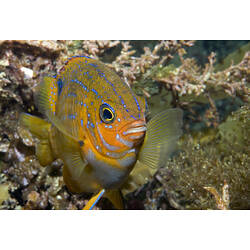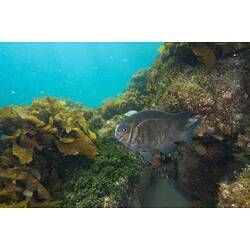General Description
Body deep, robust with a single long-based dorsal fin, a small mouth, large body scales and a scaly sheath over bases of dorsal and anal fins. Colour variable, large adults dark greyish to black, or rusty-coloured with a dusky head and pale spots along lateral; juveniles bright orange with neon-blue lines, spots and a black ocellus (false eye-spot) on rear of dorsal fin. Usually 15 cm long head to tail tip (up to 19 cm).
Biology
Like many damselfishes, the juveniles are brilliantly coloured with an ocellus or "false eye spot" on the dorsal fin. They inhabit rocky reefs in bays and estuaries, and are often seen in tide pools. Males and females are very territorial and pairs defend plots of benthic algae on which they feed. During the breeding season, the males fiercely guard their nesting sites on rock faces and boulders.
Distribution
Southern Australia.
Habitat
Shallow rocky reefs.
More Information
-
Animal Type
-
Animal SubType
-
Brief Id
Body deep, oval, scales large; greyish, brownish or black, juveniles bright orange with neon-blue markings and a "false eyespot" on dorsal fin.
-
Habitats
-
Diet
Omnivore
-
Diet Categories
Algae, Invertebrates
-
Endemicity
-
Commercial
No
-
Conservation Statuses
CITES: Not listed, FFG Threatened List: Not listed, EPBC Act 1999: Not listed, IUCN Red List: Least Concern
-
Depths
Shallow (1-30 m)
-
Water Column Locations
On or near seafloor
-
Taxon Name
-
Scientific Author
(Günther, 1863)
-
Common Name
Scalyfin
-
Kingdom
-
Phylum
-
Subphylum
-
Superclass
-
Class
-
Order
-
Family
-
Genus
-
Species Name
victoriae













